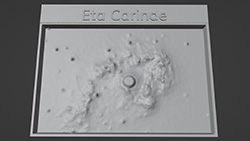CXC Home | Search | Help | Image Use Policy | Latest Images | Privacy | Accessibility | Glossary | Q&A
1
X-ray, & Optical Images of Eta CarinaeCredit: X-ray: NASA/SAO/GSFC/M. Corcoran et al; HST: NASA/ESA/STScI; Image Processing: NASA/CXC/SAO/L. Frattare, J. Major, N. Wolk
A Chandra data time-lapse sequence of Eta Carinae with frames from 1999, 2003, 2009, 2014, and 2020 -- along with observations from ESA’s XMM-Newton -- allows astronomers to watch as the stellar eruption continues to expand into space at speeds up to 4.5 million miles per hour. The “Great Eruption,” seen on Earth in the 19th century, produced a dense pair of spherical gas clouds now called the Homunculus Nebula on opposite sides of the system’s two stars.
The Homunculus is clearly seen in a separate composite image of the Chandra data (orange) with optical light from the Hubble Space Telescope (blue, purple, and white).
The Homunculus is clearly seen in a separate composite image of the Chandra data (orange) with optical light from the Hubble Space Telescope (blue, purple, and white).
2
3D Printable Files: Eta Carinae (3D Print Credit: NASA/CXC/A. Jubett, using software by Tactile Universe/N. Bonne & C. Krawczyk & Blender)
This tactile plate features a relief map of a Chandra X-ray image of Eta Carinae, a cosmic explosion that sky watchers have been observing since the middle of the 19th century. About 180 years ago, a huge explosion inside the Eta Carinae star system ejected massive amounts of material in an event dubbed the “Great Eruption”. The resulting gas and debris cloud has been expanding ever since.
In the plate, a distinct ball is encircled by a patchy ring of material. The ball represents X-rays from two massive stars, 30 and 90 times the mass of our sun. These stars are too close together to be felt individually. The oblong gas ring encircling them is tilted, stretching toward our upper right and lower left.
In the plate, a distinct ball is encircled by a patchy ring of material. The ball represents X-rays from two massive stars, 30 and 90 times the mass of our sun. These stars are too close together to be felt individually. The oblong gas ring encircling them is tilted, stretching toward our upper right and lower left.
Return to: Chandra Rewinds Story of Great Eruption of the 1840s (September 26, 2023)












